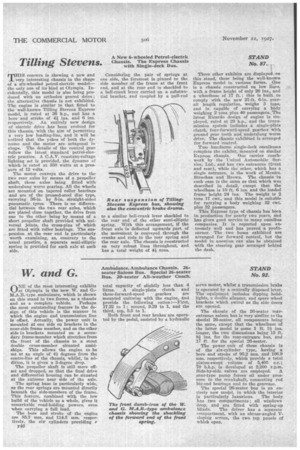W. and G.
Page 170

If you've noticed an error in this article please click here to report it so we can fix it.
ONE of the most interesting exhibits at Olympia is the new W. and G.M.A.B.-type ambulance, which is shown on this stand in two forms, as a chassis and as a complete vehicle. Perhaps the most outstanding feature in the design of this vehicle is the manner in -which the engine and transmission line is offset. Actually, the power unit is mounted at one side on brackets in the near-side frame member, and on the other side in brackets mounted on a secondary frame-member which stretches from the front of the chassis to a stout double cross-member situated amidships. This allows the engine to be set at an angle of 4i degrees from the centre-line of the chassis, whilst, in addition, it is given a 3-degree drop.
The propeller shaft is still more offset and dropped, so that the final drive and differential housing can be situated at the extreme near side of the axle.
The spring base is particularly wide, as the rear springs are mounted directly beneath the side-members of the frame. This feature, combined with the low build of the vehicle as a whole, gives it remarkable road-holding powers, even when carrying a full load.
The bore and stroke of the engine are 85.7 mm. and 114.3 mm. respectively, the sir cylinders providing
HO
total capacity of slightly less than 4 litres. . A single-plate clutch and
three-forward-speed gearbox are mounted unitwise with the engine, and provide the following ratios :—First, 17.22 to 1; second, 9.29 to 1, and the third, top, 5.5 to 1.
Both front and rear brakes are operated by the pedal, assisted by a hydraulic servo motor, whilst a transmission brake is operated by a centrally disposed lever. The equipment includes dipping headlights, a double silencer, and spare wheel brackets which swivel as the side doors are opened.
The chassis of the 26-seater rearentrance saloon bus is very similar to the special 26-seater, all components being the same, except that the wheelbase of the latter model is some 1 ft. 31 ins. longer, the two dimensions being 15 ft. 81 ins, for the rear-entrance bus, and 17 ft. for the FTecial 26-seater.
The power unit of these chassis is of the six-cylinder type, having a bore and stroke of 95.2 mm. and 106.9 mm. respectively, which provide a total piston-swept volume of 5,403 c.c.; 70 b.h.p. is developed at 2,200 r.p.m.
Side-by-side valves are employed. A gear-type pump forces oil under pressure to the crankshaft, connecting rod big-end bearings and to the gearcase.
The special 26-seater bus is an entirely new model, in which the interior
is particularly luxurious. The body has two compartments ; all windows drop, and are fitted with spring-up blinds. The driver has a separate compartment, with an obtuse-angled Vsloping screen, the two top panels of which open.


















































































































































































































































































































